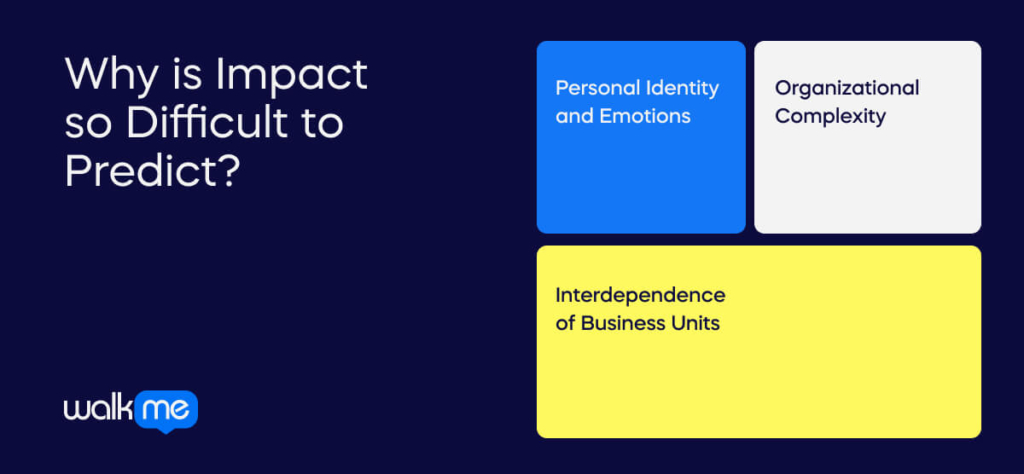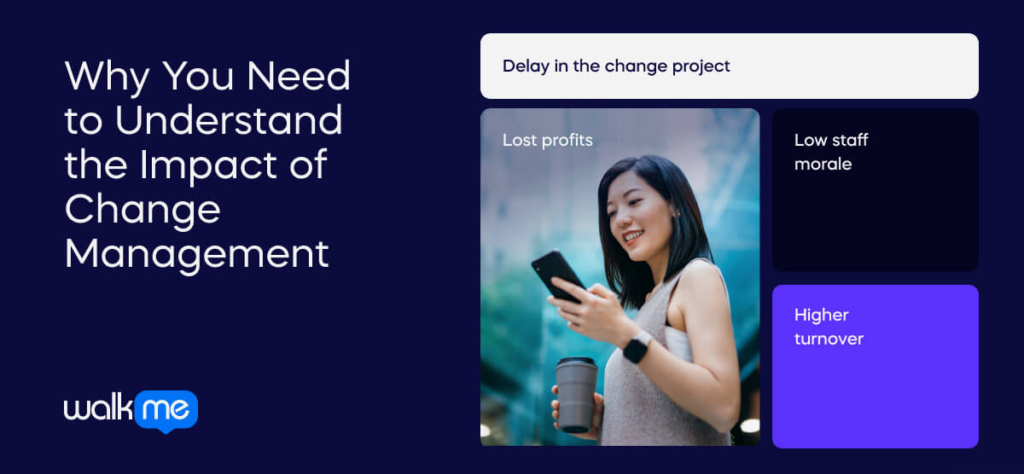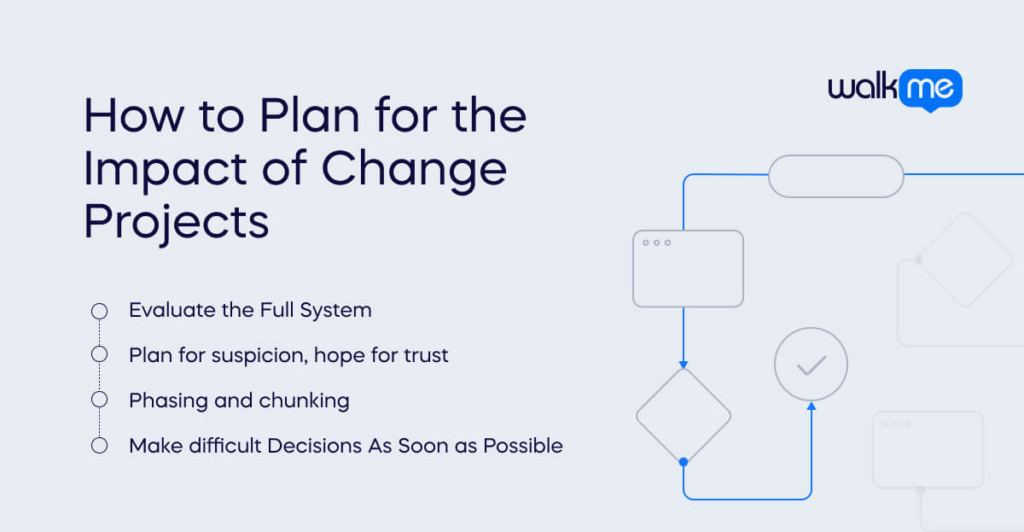The impact of any kind of Organizational Development process can be complex, uncertain, and volatile.
Inexperienced change managers may be surprised by this. They plan their change initiatives well and implement them the best they can, only to find a series of negative consequences they never thought of. They might find that the positive impacts of the change project don’t weigh up against the downsides.
However, experienced change management leaders know better. They understand that moving away from a status quo will always unsettle the entire organization. They know that successful organizational change depends on predicting every implication of their project. In short, they understand that they must undertake an impact analysis early in their planning process.
In this article, we will talk you through the basics of impact in change projects. We’ll give you a good definition of “impact” and explain why it’s so unpredictable. Finally, we’ll share some top tips on how your project can make the best impact possible.
If you’re new to change management, the impact is a topic you must start thinking about!
What is Impact in Change Management?
In a change project, the impact is the effect of the change: on the organization, its people, and its processes. Impact includes all the ways that the project will influence working practices. That could consist of workflow, the level of disruption, and the potential outcomes for the organization and its stakeholders.
Of course, leaders of organizational change management try to make the impact purely positive. However, the effect of the change is highly unpredictable. Let’s dig a little deeper into the reasons why.
How Impact is Different from Outcomes
“Impact” overlaps with concepts like outcomes, KPIs, and change management metrics. However, the impact is much bigger than any of these factors.
Leaders define KPIs at the start of a project. In general, they should be narrowly focused. They indicate the most important things you want to achieve from a project. By contrast, the impact is not just about the planned outcomes. It covers the whole experience of the change project – all the ripples that come from the planned change actions.
Some of those effects will be positive. But some of them will be negative – and it may be very hard to see them coming.
Why is Impact so Difficult to Predict?

Business organizations are complex and interdependent systems. They are operated by staff whose personal identities are bound up with their work. These are just facts of life – but they make it difficult to predict the impact of one change project.
Change has a deep effect on people in an organization. Employees often have a strong feeling of personal identity in their work – at whatever level of their business. Even small changes can create a major hit on employee morale. We can call this “resistance to change.” But the reality is we are dealing with very human emotions. And as we all know, feelings do not always behave rationally or logically.
In terms of the organization itself, the system’s complexity makes it harder to predict impact. For example, implementing a new ERP sounds easy – until you consider that every department tracks its processes using a completely different set of legacy systems. Alternatively, a cultural change is impossible when different staff groups have widely different values.
Finally, the interdependence of business units makes it difficult to see how impact will work. A change in one small part of the business could have unexpected consequences in another part. If you don’t understand these knock-on effects, they will come as a surprise further down the line.
Why You Need to Understand the Impact of Change Management

If you fail to adapt to the impacts of change, the outcomes of your initiatives can spell big losses. That might include:
- Delay in the change project (or even derailing it completely)
- Lost profits
- Low staff morale
- Higher turnover.
However, if you plan for the impact of change, you can avoid these negative consequences.
How can Change Projects have such a Negative Impact?

Let’s take a moment to walk in the shoes of a rank-and-file staff member. Their employee is making some big changes. The leaders believe that those changes will go down well. So why would an individual staff member care?
As we’ve said, when dealing with employees, we cannot think rationally. Researchers have found that responses to change can include:
- Shock
- denial
- powerlessness
- frustration
- loss of self-esteem
- alienation
- emptiness
- feelings of insecurity
Does this sound extreme? Maybe. But just think of all the time employees spend at work. Then, think about how long they’ve lived in the same routine. Whatever ups and downs they’ve had in their private lives, their workplace has remained certain. And now – that’s all going to change.
In any situation, human responses are difficult to make plans for. But they are all potential impacts of your project.
And quite aside from the human aspect of change management, every project might have implementation issues and unintended consequences that lead to completely unpredictable outcomes. Technical difficulties, unexpected costs, and problems with training can all send a change initiative spiraling into the abyss.
How to Plan for the Impact of Change Projects

So, some negative consequences will almost certainly come from your change project. What can you do to mitigate them?
If you’re reading this article, you’ve already made a good start. At the very least, you can ensure you are NOT among the 37% of executives who, according to KPMG, underestimate the significance of change to their operating models.
In this section, we’ll discuss a few ways to plan effectively for the best project outcomes. It’s essential to evaluate the full system you’re dealing with. You should anticipate that people will deal badly with the change – and you should plan your rollout with time to adjust.
Evaluate the Full System
As far as possible, you must do an impact analysis considering every part of the organization. This is much easier said than done.
Fortunately, one of several models can help you achieve this.
- ProSci’s model identifies ten areas that the change can impact. These are processes, systems, tools, job roles, critical behaviors, attitudes/beliefs, reporting structure, performance reviews, location, and compensation. This wide-ranging checklist will make it much easier to predict problem areas.
- A simpler model is Leavitt’s Diamond. In this framework, leaders consider how a change in one business unit can impact people, tasks, structure, and technology.
- Alternatively, there are several models for change management that will help to plan for unpredictable events. Guiding your change management project with ProSci’s ADKAR, the McKinsey 7Ss, or Kotter’s 8-step model will help you consider the impact in many different areas of your company.
Plan for suspicion, hope for trust
A 2020 report from Gartner showed that “Employees who report high trust have an average capacity for change that is 2.6 times greater than those with low trust.” The implication is simple. To improve all aspects of your employee’s experience of change, trust is one of your most valuable assets.
Some of the strategies should be obvious to experience leaders. Transparency, clear communication, and involvement of staff will go a long way.
But just remember that the psychological impact of change can run extremely deep. As such, your managers show empathy towards all employees. They must be ready to be understanding and sympathetic, even if they will not compromise.
Building trust will come naturally to some leaders. To others, it will be a major challenge. Make sure your whole leadership hierarchy is fully prepared for this challenge.
Phasing and chunking
In a major change project, you don’t need to implement every change simultaneously. That’s why a phased change program can be a critical strategy for mitigating negative impacts.
From the perspective of organizational change, the incremental approach has several benefits. Minor changes only cause small disruptions – the unpredictable impacts can be handled one at a time before moving on to the next stage. Each phase can teach valuable lessons about the impact of the change process.
As a result, smaller efforts are easier to achieve and provide a fruitful learning curve.
Make difficult Decisions As Soon as Possible
Let’s face it: not everyone will make the cut in some change projects.
You might be looking to cut a big chunk of staff. Or perhaps your leadership team will need some new faces.
Don’t waste time. Bring the decision-making process forward – and get the tough choices sorted. That will make it easier to address changes with the remaining staff.
Do You Understand The Impact of Change Management?
In this article, we’ve had a crash course on the impact of change.
We saw that “impact” is not just the metrics and KPIs of a change process. Impact includes all the difficult things you don’t expect: from people, processes, and implementation. The unpredicted impact can spoil an excellent project – so it’s worth spending time and effort to improve your expectations. Fortunately, there are several proven ways you can make plans for impact. Depending on the nature of your change project, you may find that other tools provide invaluable support to your work. For example, in a digital transformation project, you need to gather a lot of information about how users engage with new technology. In this case, a digital adoption platform can provide insights at every step of the journey.

